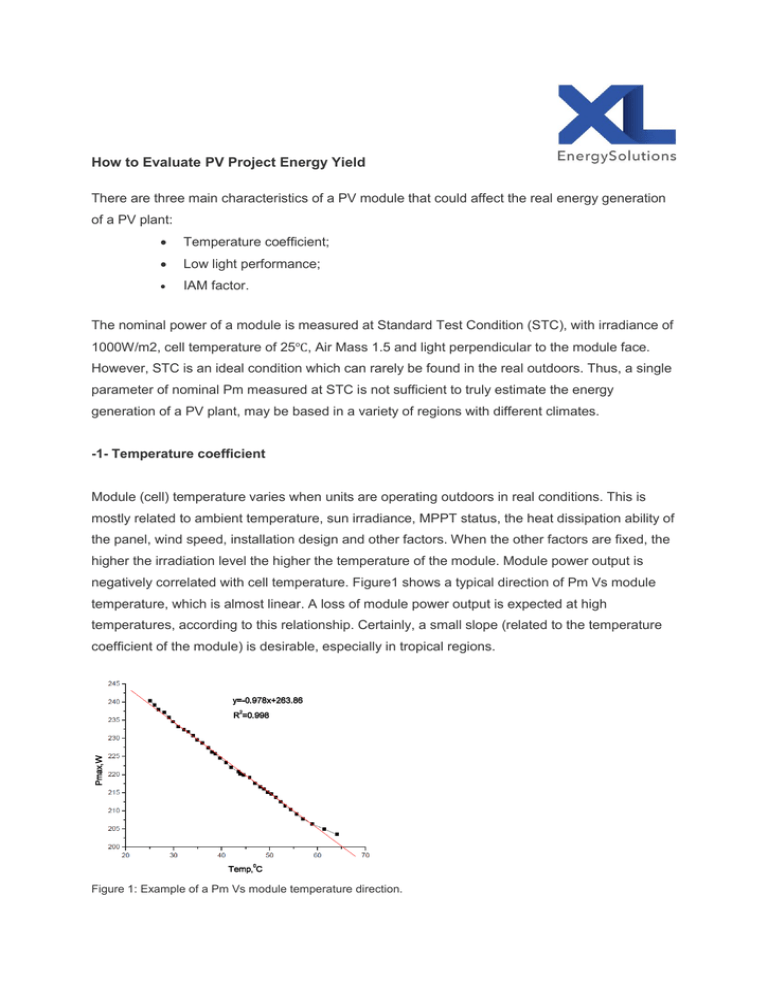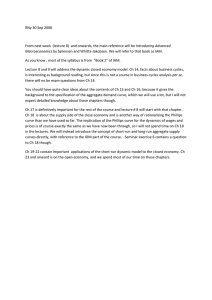How to Evaluate PV Project Energy Yield - XL
advertisement

How to Evaluate PV Project Energy Yield There are three main characteristics of a PV module that could affect the real energy generation of a PV plant: Temperature coefficient; Low light performance; IAM factor. The nominal power of a module is measured at Standard Test Condition (STC), with irradiance of 1000W/m2, cell temperature of 25℃, Air Mass 1.5 and light perpendicular to the module face. However, STC is an ideal condition which can rarely be found in the real outdoors. Thus, a single parameter of nominal Pm measured at STC is not sufficient to truly estimate the energy generation of a PV plant, may be based in a variety of regions with different climates. -1- Temperature coefficient Module (cell) temperature varies when units are operating outdoors in real conditions. This is mostly related to ambient temperature, sun irradiance, MPPT status, the heat dissipation ability of the panel, wind speed, installation design and other factors. When the other factors are fixed, the higher the irradiation level the higher the temperature of the module. Module power output is negatively correlated with cell temperature. Figure1 shows a typical direction of Pm Vs module temperature, which is almost linear. A loss of module power output is expected at high temperatures, according to this relationship. Certainly, a small slope (related to the temperature coefficient of the module) is desirable, especially in tropical regions. Figure 1: Example of a Pm Vs module temperature direction. Generally, in different wafer/cell quality and module encapsulation processes, the Pmax temperature coefficient of the current crystalline silicon PV modules from different manufacturers varies within the range of -0.4%~-0.5%/ oC. There is sound evidence from third-party institutions and the ReneSola Module Lab, that the temperature coefficient of the ReneSola Virtus II polycrystalline silicon module is about 0.40%/oC, one of the lowest among all PV module suppliers, which indicates more energy generation compared with other crystalline silicon modules. The decrease in Pm when there is an increase in temperature is mainly attributed to the decrease of the voltage of the module. Typical I-V curves at different temperatures are shown in Figure 2. The VOC of the module obviously decreases while the ISC of the module increases a bit as the cell’s temperature goes up. Figure 2: Typical I-V characteristic curves of PV module at different temperatures. -2- Low light performance In most parts of the world, 1000 W/m2 irradiance is a very high level for real outdoor meteorological conditions. Irradiation at 400~1000W/m2 plays and important role in energy generation. So, low light (below 1000W/m2) performance is also very important. Efficiency curves for ReneSola polycrystalline modules at various irradiation levels and temperatures, as measured by third-party institutions, are shown in Figure 3. There is no or very little degradation of the module efficiency above 400W/m2, compared with that at STC. This excellent low light performance of ReneSola modules can improve the energy yield for PV project investors. Figure 3: Efficiency curves for ReneSola Virtus II polycrystalline modules at various irradiation levels and temperatures. The International Electrical Commission standard IEC 61853-1 defines conditions for measuring the power output of solar modules at various cell/environment temperatures and irradiation levels, as shown in Table 1 below. The corresponding test data from ReneSola Virtus II module, as measured by PV Evolution Labs (PVEL, shown below in Table 2) indicated outstanding temperature and low-irradiation level behavior. -3- Incidence Angle Modifier (IAM). Above, we explained the impact of module temperature and low light performance on the energy yield of photovoltaic (PV) modules. Below, we explain another parameter, Incidence Angle Modifier (IAM). At Standard Test Condition (STC), sunlight is assumed to vertically project onto module surfaces, but this is not true for most outdoor time; even diffuse light is not considered. Usually, reflectance increases as the angle of incidence (“θ” is defined in Figure 1) increases, which will lead to a decrease in both light absoption and module efficiency. Figure 1: Angle of incidence on a solar panel surface. Incidence Angle Modifier (IAM(θ)) is introduced to correct such inconformity. When IAM(0) is 1, it means light is vertically projected onto the module surface. As shown in Figure 2, the IAM factor slightly decreases as the angle of incidence increases, and sharply drops when it exceeds a critical angle (this is an example for a crystallaine silicon module). Figure 2: IAM setting in PVsyst default settings. Figure 3: IAM measurement apparatus. The IAM of ReneSola Virtus II high-efficiency polycrystalline modules was measured by PV Evolution Labs (PVEL), a leading solar panel performance and reliability testing lab. The results are shown in Figure 4. Figure 4: IAM values of ReneSola’s polysilicon module as measured by PVEL. According to the measured results, we recommend PVsyst users define IAM values rather than using default values for ReneSola modules. The comparison between the actual and default IAM plots is shown in Figure 5. Figure 5: Default IAM setting in PVsyst and measured/recommended IAM plots. To estimate the net annual energy yield difference resulting from using different IAM data, PVsyst simulations were made. We strongly recommended useing IAM values based on the practically measured results to predict the annual energy yield of a PV system. The recommended IAM profile results in higher expected energy yield. The expected energy yield based on the measured IAM, relative to the default IAM function in Pvsyst, was +1.3% more in an assumed system in Las Vegas, and +2.4% more for another in Boston, as reported by PVEL. Table 1: Energy yield difference between default and PVEL recommended IAM values. Table 2: Energy yield difference between default and PVEL recommended IAM values. November 2014





